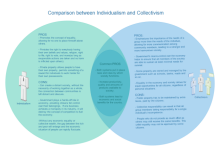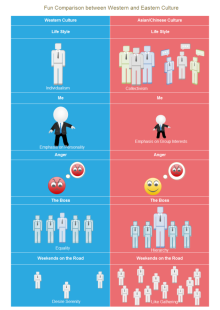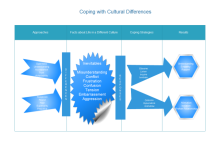Cultural Difference Diagrams
What Is Culture Shock
Culture shock is a logical reaction to differences we come across when people meet a different culture. There are various phases that you may experience:
- You're fascinated with all the new things you are experiencing.
- You're feeling a little uncomfortable because you feel you don't belong or fit in the new culture.
- You're rejecting the foreign culture and its people, finding them strange and exclusive.
- You're learning to interpret foreign behavior.
- You're accepting the differences and enjoying the foreign culture.
Cultural differences often lead to amusing misunderstandings, and can also have a serious impact on people's career. To avoid cultural conflicts, one should get familiar with them first. Common knowledge of cultural conflict can help people leave a good impression and carry out better communication. Below are a few diagrams which illustrate this topic in a visual and easy to understand way.
Tips to Cope with Culture Shock
Coping cultural difference requires appropriate approaches. Most importantly, acceptance and mutual understanding are the prerequisite. Below are more tips to ease culture shock.
- Tip 1: Do some research before going abroad. By preparing well, you can adapt faster.
- Tip 2: Keep an open mind and a positive attitude.
- Tip 3: Make friends with natives. Local people will inform, guide and help you reverse culture shock.
- Tip 4: Keep yourself busy. While you are experiencing new things and fulfilling meaningful tasks, you won't feel so lonely.
Visual Diagrams about Cultural Differences
This Venn diagram compares two different ideologies in terms of both PROS and CONS.
This diagram is very simple but it demonstrates the differences very vividly. It is true that simple is best. All viewers can understand it instantly. You can also make such kind of diagrams easily in Edraw. Various clipart and shapes are available for more possibilities.
This diagram illustrates suitable and inappropriate methods to cope with culture conflict. It is people's attitude rather than culture conflict itself that will exert negative effect on people.
More Examples |
Visuals about China |





